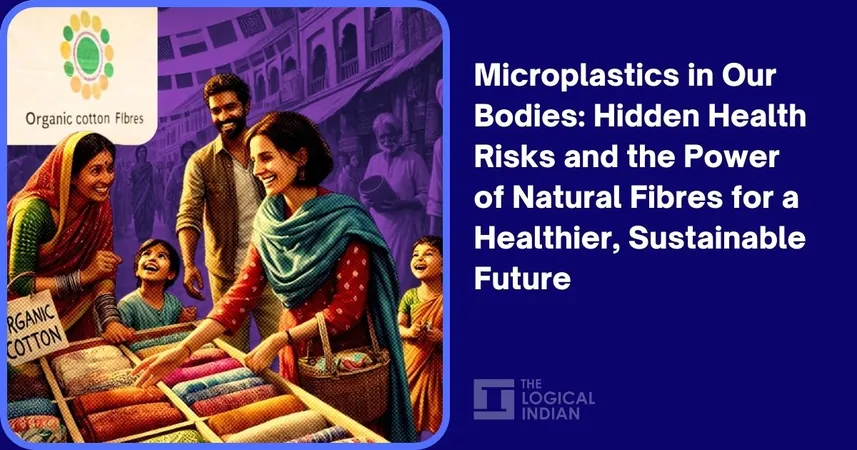
Microplastics in Our Bodies: The Hidden Health Risks and the Necessary Shift to Natural Fibers
2024-12-28
Author: Yu
Microplastics—tiny plastic particles that are less than 5 mm in size—are increasingly infiltrating our environment, raising serious health concerns for both humans and wildlife. Originating from the degradation of larger plastic items, these pollutants are now alarmingly prevalent in the air we breathe, the water we drink, and the food we consume. Experts warn of a range of potential health risks associated with microplastics, including respiratory issues, reproductive health problems, and cardiovascular concerns.
The Microplastics Crisis: What You Need to Know
Microplastics come from various sources, such as the breakdown of synthetic materials used in clothing, packaging, and household items. Their small size allows them to bypass biological barriers, entering human tissues and leading to a myriad of health risks currently under intense research scrutiny. Recent studies have highlighted alarming findings, indicating that microplastics can accumulate in our bodies and might be linked to oxidative stress, inflammation, and even cancer.
The Health Risks of Microplastics: A Wake-Up Call
The implications of microplastics on human health are increasingly concerning. Investigations suggest that these pollutants can lead to: - **Respiratory Issues:** Inhaling microplastics may cause significant oxidative stress in the lungs, potentially leading to chronic respiratory diseases. - **Reproductive Health Problems:** Research has drawn connections between microplastic exposure and diminished fertility rates in males, a trend that could affect future generations. - **Cardiovascular Risks:** Newly emerging evidence indicates that microplastics could elevate the risk of serious cardiovascular events, including heart attacks and strokes.
Moreover, the discovery of microplastics in human blood further highlights the urgency of addressing this pervasive issue.
Natural Fibers: A Sustainable Solution
One of the most effective strategies for combating the rising tide of microplastics is the shift toward natural fibers. Unlike synthetic fibers such as polyester and nylon, which release microplastic particles during washing and everyday wear, natural fibers like cotton, wool, and linen are biodegradable and safe for the environment.
Benefits of Embracing Natural Fibers:
1. **Environmental Impact:** Using natural fibers decreases dependency on plastics and diminishes the overall demand for synthetic materials, making a positive environmental impact. 2. **Healthier Choices:** Natural fibers are typically less likely to irritate the skin or provoke allergies, offering a more comfortable alternative to synthetic clothing. 3. **Sustainability:** Many products made from natural fibers are produced using sustainable methods, minimizing ecological harm.
Real-Life Example: Making the Change
Take the story of Riya Sharma from Bangalore. Inspired by community workshops on microplastics, she consistently replaced items in her wardrobe with organic cotton and linen alternatives. "I feel empowered to know that I'm making a difference by reducing plastic waste," she recounts.
Taking Action for a Healthier Future
To actively contribute to mitigating microplastic pollution, consider adopting the following practices: - **Reduce Single-Use Plastics:** Embrace reusable bags, containers, and bottles to significantly cut down on plastic waste. - **Support Sustainable Brands:** Choose to purchase from companies committed to eco-friendly practices and the use of natural materials. - **Spread Awareness:** Share knowledge about the impacts of microplastics with family and friends, encouraging informed consumer choices.
Community Engagement and Expert Insights
Participate in local cleanup efforts or support organizations like "Plastic Free India" that conduct monthly beach clean-ups while educating the community on sustainable practices. Experts emphasize that if every individual swapped just one synthetic item for a natural alternative annually, we could collectively make a meaningful reduction in plastic pollution.
In light of recent findings showing microplastics contaminating the human body—a veritable wake-up call—the need for urgent action is more pronounced than ever. Advocating for sustainable practices across personal consumption and industrial production is crucial in turning the tide against plastic pollution.
Conclusion: Uniting for Change
As we grapple with the challenges posed by accelerating plastic pollution, which is projected to double by 2040 under current trends, we must recognize our individual roles in this crisis. By making conscious lifestyle changes, such as opting for natural fibers and minimizing plastic use, we can foster a healthier future for ourselves and the generations to come. The journey toward a cleaner planet begins with the small, purposeful choices we make today.
Together, let’s embrace this responsibility and champion a sustainable coexistence with our environment—because every action, however small, contributes to a larger movement toward peace and sustainability. How do you plan to reduce your plastic footprint? Join the conversation and take actionable steps today!


 Brasil (PT)
Brasil (PT)
 Canada (EN)
Canada (EN)
 Chile (ES)
Chile (ES)
 Česko (CS)
Česko (CS)
 대한민국 (KO)
대한민국 (KO)
 España (ES)
España (ES)
 France (FR)
France (FR)
 Hong Kong (EN)
Hong Kong (EN)
 Italia (IT)
Italia (IT)
 日本 (JA)
日本 (JA)
 Magyarország (HU)
Magyarország (HU)
 Norge (NO)
Norge (NO)
 Polska (PL)
Polska (PL)
 Schweiz (DE)
Schweiz (DE)
 Singapore (EN)
Singapore (EN)
 Sverige (SV)
Sverige (SV)
 Suomi (FI)
Suomi (FI)
 Türkiye (TR)
Türkiye (TR)
 الإمارات العربية المتحدة (AR)
الإمارات العربية المتحدة (AR)